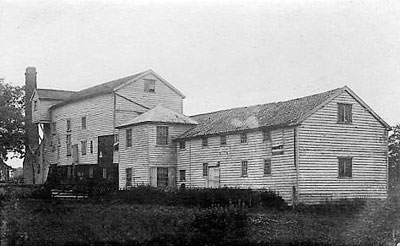 |
c.1904 |
Dilham Mill River Ant / North Walsham & Dilham Canal |
 |
c.1904 |
Dilham watermill built of weatherboard over a brick base with a Norfolk pantile roof. A substantial two floored weatherboarded storage building was attached to one gable end. In 1900 the mill was described as having 4 floors of engine and boiler houses. The breastshot waterwheel had a fall of 8 feet that drove 2 pairs of stones and its water was taken from the 25 acre Dilham Lake. In later years, water power was supplemented by a steam engine and the nearby Dilham_smockmill was under the same ownership. The watermill almost certainly stopped working before the first World War c.1910. |
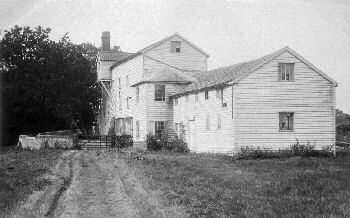 |
c.1905 |
Watermill and house, Scottish Close (4a) with house (described as newly-built in 1597) meadow (4a), all in Dilham, with piece of moorland in Honing, leased by Thomas Windham to Thomas Hill and others for 21 yrs in 1578; to Thomas Hill for 21 years in 1597; to John Willyson for 11 yrs in 1621; to Francis Calfe and others for 21 yrs in 1636, with bond to observe covenants, 1641. Norfolk Record Office |
To be Sold TWO WINDMILLS with their going Geers, one being near St._Giles_Gates, Norwich and the other at North_Walsham in Norfolk. Also the Remainder of a Term for sixty years which commenced in 1747 of a good water mill with a Dwelling House and small farm adjoining, being in Dilham, late occupied by Mr. Joseph Cole. For further Particulars enquire of Mr. Marker at Dilham aforesaid, Mr. Gaze of Paston, or Mr. Gay of North Walsham. All such Persons as are indebted to the said Joseph Cole are desired to discharge the same immediately to some of the abovesaid Persons or they may be sued. Norwich Mercury - 7th November 1761 |
Royal Exchange Fire Insurance policy 62407 |
Jno. Withers of North Walsham in the County of Norfolk. On a Water Corn Millhouse brick built weatherboarded & tiled & on the Mills therein together with the Running Tackle & other parts of the Machinery belonging thereunto situate in Dilham in the County aforesaid in his owb Occupation, £400. On a House brick built & thatch'd situate on Eastgate Common near North Walsham aforesaid Tent. ----- Victualler & known by the Sign of the White House, £200. On a Brewhouse brick built & tiled situate in ye Yard belonging, £50. On a Granary near brick, stud & plaister built & thatch'd, £50. 6th December 1773. |
Royal Exchange Fire Insurance policy 129809 |
Rob. Colls of Worstead in the County of Norfolk, Merchant. On his Water Mill including the Going Gears & Machinery therein brick, stud & tiled fituate in Dilham in the County aforesaid - £300. 12th September 1792 |
Royal Exchange Fire Insurance policy 144814 |
James Hovell of Dilham in the Co. of Norfolk, Miller. On a Water Corn Mill Brick & Timber & tiled sit. at Dilham afsd. - £100. On the Water Wheel, Standing & Going Geers, Mill Stones, Wire Machines & Drefsing Mills therein - £50. On Stock and Utensils including Boulting Cloths, Sacks and other moveable Utensils in the same - £200. Warranted to have no Kiln. 25th March 1795 |
Jonathan Cobb, flour dresser |
1770 (aged 19) Jonathan Cobb bound "himself" apprentice to John Withers of North Walsham flour dresser by indenture for 6 years and served three." [Settlement Examination of Jonathan Cobb 1783 by Magistrate in North Walsham.] 1773 Jonathan left John Withers to finish his apprenticeship in Great Yarmouth, thereby losing his right to Settlement at North Walsham. 1773-75 Jonathan served the remainder of his 5 year apprenticeship in Great Yarmouth [Settlement Examination of Jonathan Cobb 1783 by Magistrate in North Walsham] R. H. Clarke Ltd, millers of Great Yarmouth have records at NRO GB/NNAF/C181322 (Former ISAAR ref: GB/NNAF/B33452) 1775 (aged 24) Jonathan managed to move back to North Walsham when he "Let himself to William Colls, then of North Walsham, flour dresser and served a term with him." William Colls, a Quaker Miller in North Walsham, also bought a wind grist mill at Letheringsett in 1757 (erected around 1764 and possibly still running) from the bankruptcy trustees of John Priest a Sheringham miller. Around that time William Colls took two apprentices; Thomas Siely in 1775, and John Chertney in 1778 (duty was paid for their indentures) 1781 Jonathan (aged 30) seems to have been living at Gorleston 1782 Feb 12 (aged 31) Jonathan Cobb single man married Elizabeth Lacey single woman (both of North Walsham at the time) at St Nicholas, North Walsham, Co Norfolk. By banns, witnesses Samuel Cobb & Richard Scott. 1783 Jan 26 John Lacey Cobb [surprisingly?] baptised at Yarmouth 1784 Susannah Cobb baptised at North Walsham 1787 Jonathan Cobb Junior baptised at Yarmouth 1791 Jonathan aged 40 living in North Walsham 1794 Mary baptised at North Walsham 1796 John, son of Jonathan Cobb of North Walsham, Miller, apprenticed to Bakers in Great Yarmouth. Yarmouth Borough Freeholders list for 1802 includes Thomas King Baker [Eldest son not a Miller, but no doubt Thomas King bought flour from Jonathan] 1798 Daughter Diana baptised and buried at Mundham 1799 Son Samuel baptised at North Walsham and 1800 buried at North Walsham Wife Elizabeth died around this time. No burial found for her yet in any local parish. On 20 Oct 1800 [aged 50] at Loddon Parish Church (Holy Trinity) Jonathan Cobb (widower) married Anne Clarke (single) by banns. Witnesses Robert Stone and Robert Ward. (from Brian Forder, Cobb rootsweb) More children baptised in Loddon, and Ashby near Loddon 1808 Jul 19 TO BE SOLD BY AUCTION by Mr Athow on Tuesday 19 July at 5 pm at the Swan Inn, Loddon, Norfolk. Several contiguous freehold cottages ... situate in the Mill Street of that town, now in the distinct occupations of George Leggett, Elizabeth Ellis, William White, Elizabeth Bales, Samuel Kerrison and Jonathan Cobb. Subject to such conditions of sale as will then and there be produced. For further particulars apply to Mr Wm Utting, Thurlton, Norfolk c.1814 Family returned to North Walsham where Jonathan was at various times described as a husbandman. 1820 Charlotte, daughter of Jonathan and Ann Cobb, miller of North Walsham, born 18th Nov, baptised 7th December 1829 Jonathan Cobb died and was buried at North Walsham aged 79 Judy Buckley - 24th June 2014 |
William Harrison Wells was born on 24th September 1805 in Martham, the son of William and Sarah Wells. William Wells snr, who was born c.1781 in Lound, Suffolk, married Sarah Harrison in Gt Yarmouth on 29th January 1804. William snr was almost certainly a miller by profession but it's not known where. He died at some time between the census in 1841 and 1851 and the 1851 census lists Sarah Wells as the widow of a miller. William jnr was given his mother's maiden name as a middle name and obviously learnt milling at an early age. He married Harriet Howes at West Somerton on 9th May 1832. |
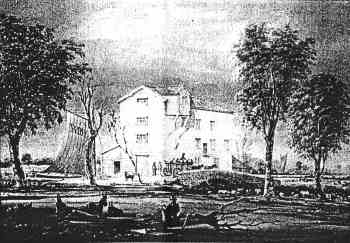 |
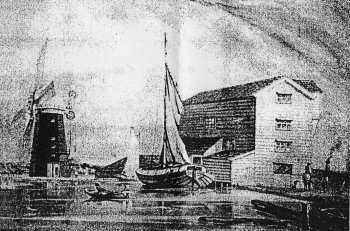 |
1834 watercolour painting by Edmund Girling |
1837 watercolour painting by Edmund Girling |
The above painting was subject to a degree of artistic licence as the windmill was not as close to the watermill or in the position shown. |
The wherry sail bears the letters WHW - William Harrison Wells of Dilham mill. The 1834 painting depicts the artist, Edmund Girling, sitting on a log in the foreground and the 1837 painting shows him rowing across the mill dam. A certain amount of artistic licence appears to have been deployed. The adjacent windmill is the smockmill, also owned by William Harrison Wells that was moved to Wymondham in 1858 via the Great Eastern Railway. William Harrison Wells was a good friend of Edmund Girling jnr (1796-1871), who along with William Stannard jnr, were London corn and flour merchants trading under the name of Girling & Stannard. They operated from Jack's Coffee House in Mark Lane, London. While Harrison was running Dilham mill he was occasionally visited by his friend and business aquaintance Girling, who was also an artist of the Norwich School and WHW commissioned him to paint two watercolours of Dilham watermill. William Harrison moved to Norwich between 1851 and 1854 and by 1864 was running New_Mills. When Girling died in 1871 he bequeathed William Harrison £300 in his will, which gives Harrison's address as New Mills and St George's. |
| John Stammers, born 1822, second son of Robert Stammers of Magdalen_Gates_post_mill, Pockthorpe, Norwich. At Wymondham 1850 - 1858. Went to Dilham watermill by 1861 and to Mendham watermill 1864. Letter from David Cubitt, Norwich, to Harry Apling - December 1982 N.B. John's brother Joseph Stammers, was miller at Mendham |
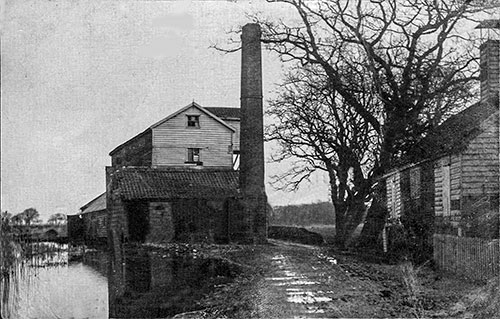 |
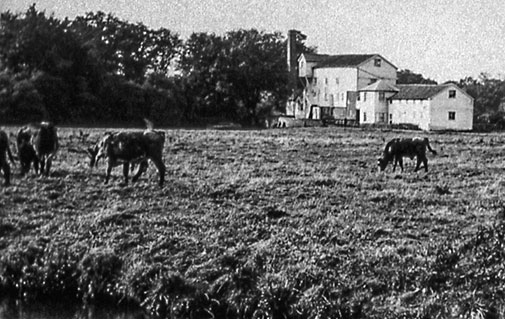 |
1909 |
c.1911 |
The North Walsham & Dilham Canal |
| This was the only official canal in Norfolk and was really the canalisation of the River Ant. It was made wider than most other canals in order to accommodate Norfolk wherries. The main cargoes were offal to the two Antingham_Bone mills with return loads of fertiliser. Corn and flour moved in and out of Bacton_Wood and Swafield mills with other commodities such as timber, farm produce and coal making up the majority of the remainder of trade. It was hoped that coal would be the mainstay cargo but this never materialised. The canal was just over 8¾ miles long, ran from Smallburgh to Antingham and contained 6 locks: Honing, Briggate mill, Ebridge mill, Bacton Wood mill, Swafield lower and Swafield Upper. 1812: Act of Parliament passed authorising construction of the canal July 1826: Canal opened having cost £32,000 to build 1885: Ailing canal sold for £600 but the company's London solicitor absconded with the money 1886: Scheme introduced to encourage tourist traffic c.1893: Antingham - Swafield section abandoned because of lack of traffic 1934: The wherry Ella, sailed from Bacton Wood Staithe for the last time 2003: Canal navigable for the first 2 miles as far as Honing Lock |
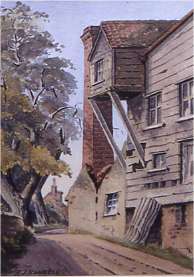 |
c.1935 watercolour |
Dilham mill originally stood across the river Ant but the river was diverted to form the North Walsham & Dilham Canal, which was completed in 1826. There is little doubt that prior to the canal being built the mill was effectively at the head of the historically navigable River Ant and was served by wherries accessing up the tail stream. This section of the Ant was, and still is to some extent, subject to tidal influence giving the right of free navigation, but the canal company could well have expected the right to charge craft using its much more direct channel up to the mill. This, however, the company was specifically prevented from doing by a special clause in the Act preserving the right of free navigation up to the mill. Despite this, it would appear that when Honing Lock was constructed fairly close to the site of the mill, steps were taken to construct a dam near the mill to create what was known as Dilham Broad or Dilham Lake and an entrance to this broad was created from the canal upstream of Honing Lock. Thereafter wherry access to the mill appears to have been southwards across the broad to the mill head and the former access via the mill tail seems to have fallen into disuse. Alan Faulkner - 16th April 2003 |
At one time the mill dam covered 25 acres and it is said that the cause was an accidental breach of the river bank in 1868. The story goes that this was the time of a disastrous drought and when a local farmer attempted to dig a tunnel to gain water, the resulting inflow quickly got out of hand and resulted in the flooding of Dilham beds. The level of the mill dam has dropped and is now below the level of the old wheel sluice. |
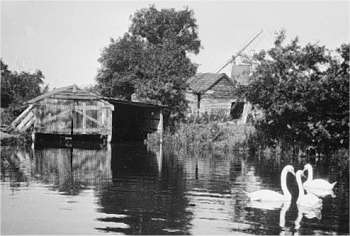 |
Dilham staithe and towermill in 1929 |
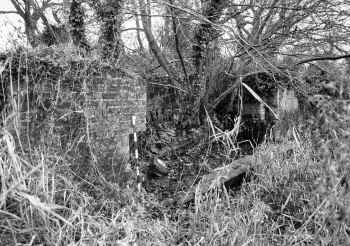 |
The wheelpit 11th December 1977 |
TO BE LET With Possession at Michaelmas next. A Capital BRICK TOWER_WIND_MILL_at_PALLING next the Sea With good Dwelling house, requisite Outbuildings and an acre of Land adjoining and now in the occupation of Thomas FRARY. The Mill drives two pair of French Stones and two Flour Mills. Apply to SEWELL, BLAKE & CO. Solrs. Norwich or to Mr. Warnes at Mr. Wells' Dilham Mills. Norfolk Chronicle - 19th September 1835 |
At one time the mill dam covered 25 acres and it is said that the cause was an accidental breach of the river bank in 1868. The story goes that this was the time of a disastrous drought and when a local farmer attempted to dig a tunnel to gain water, the resulting inflow quickly got out of hand and resulted in the flooding of Dilham beds. The level of the mill dam has dropped and is now below the level of the old wheel sluice. |
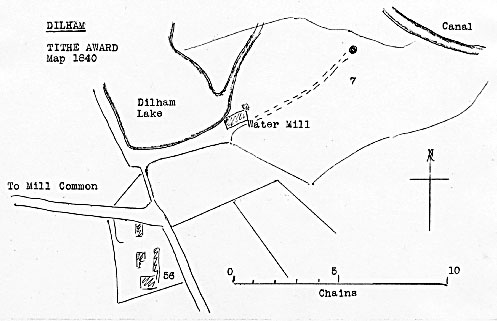 |
Tithe map 1840 - as redrawn by Harry Apling |
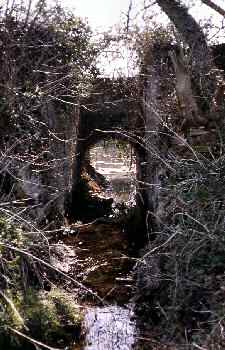 |
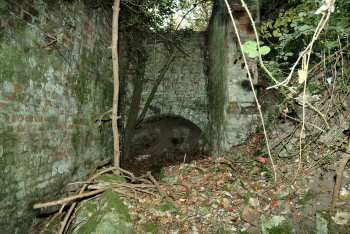 |
Wheelhouse 15th April 1983 |
Wheelhouse 19th October 2003 |
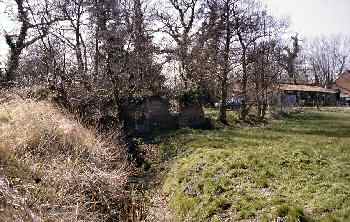 |
The headrace 15th April 1983 |
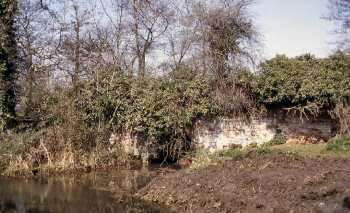 |
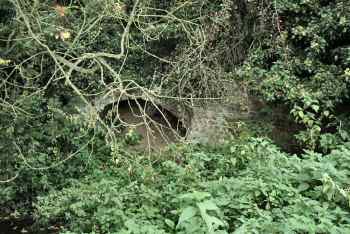 |
Tailrace arch 15th April 1983 |
Tailrace arch 19th October 2003 |
Dilham Wind & Water Mills - Tithe Award 1841 |
|
| No. 5: Water Mill etc. Water | 16a. 0r. 11p. |
| No. 6: Mill Rand. Pasture | 0a. 1r. 30p. |
| No. 7: Windmill Meadow. Pasture | 5a. 2r. 2p. |
| No. 8: Mill Pightle. | 1a. 0r. 7p. |
| No. 11: Little Mill Meadow | |
| No. 12: Great Mill Meadow | |
| No. 16: Windmill Pightle. Arable | 1a. 3r. 29p. |
| No. 56: House, Farm Premises & Garden | 1a. 0r. 8p. |
Total: |
53a. 3r. 38p. |
| £3. 13s to Vicar £6 17s to Appropriators |
4 floors of engine and boiler houses undershot waterwheel driving 2 pairs of stones mill with fall of 8 feet Let to Mr. W. Stackwood yearly tenant at £25 pa Dilham Sale Particulars - 1900 |
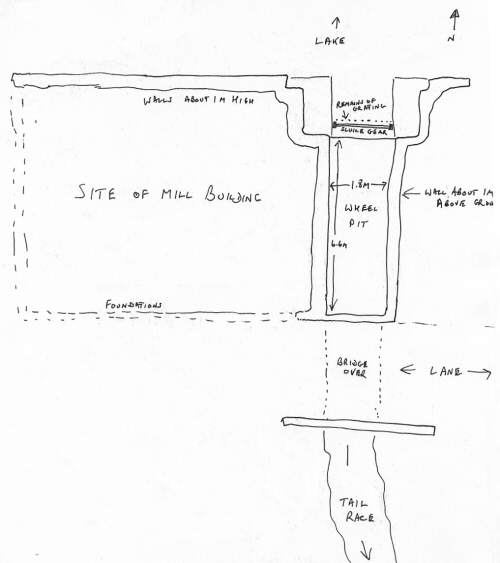 |
NIAS plan December 1977 |
All that remains now is the brick wheelpit, 1.8 metres wide and 6.6 metres long, with the remains of gearing for adjusting the breast sluice. On the north and east sides the walls of the mill survive to a height of about one metre but the south and west walls have disappeared entirely. NIAS Report - 11th December 1977 |
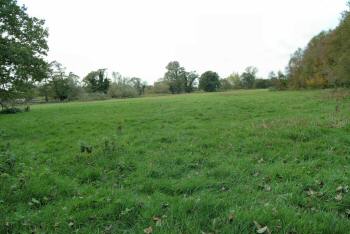 |
Dilham Broad bed 19th October 2003 |
William Harrison Wells was born on 24th September 1805, the son of William and Sarah Wells. Sarah's maiden name was Harrison. |
William Stackwood snr moved from Bolwick_watermill in the 1880s, where he had been working as a journeyman miller along with his son William jnr. who temporarily remained at Bolwick. By 1891 William Stackwood snr had moved to Cawston and taken over Sygate Black Mill and White Mill. William Stackwood snr had at least 14 children during his two marriages and 9 of them were known to have married in Norfolk. |
When I purchased Dilham House in 1968, I also had the opportunity to purchase Dilham Broad which was part of the deeds of Dilham House. It was sold to the Patterson family who converted it to pasture. |
'Forgotten' Norfolk broad could be re-flooded and restored |
A Norfolk farmer hopes to recreate a long-lost "forgotten broad" - an idea which he says could benefit a heritage waterway, tourism and agriculture. |
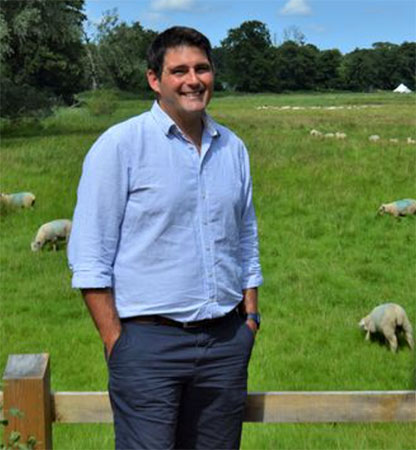 |
| He said this could restore a piece of Broadland heritage, create a watersports asset for his farm's growing tourism and camping enterprise, and act as a winter storage reservoir for his farming operations. "I've seen it referenced as the secret or forgotten broad, " said Mr Paterson. "It is a long-term ambition to restore it. It is not something that is going to happen overnight, but it would be quite nice to put back something that was there before. "It could be used for paddle-boarding, canoeing, maybe sailing. It could also work as a winter storage reservoir for me as well, so if we get lots of flood water coming down the canal we could store it to use in the summer time on our crops. "It could be a win-win on the farming, a win-win on the tourism, and a win-win on heritage restoration." Mr Paterson is the fourth generation of his family to farm at Dilham Hall, near North Walsham. Dilham Lake appears on a 1906 map hanging on the wall of the farm office, which shows the mill, lakeside boathouses and the 14-acre water body - although earlier references suggest it was 25 acres. Mr Paterson said his family were previously dairy farmers, which prompted the decision to drain the lake to create grazing land for the cows. "Now the direction of travel for our business is very much tourism, so having 14 acres of water and an old mill would be a lovely story to put some heritage back," he said. He is now exploring the necessary permissions and licences that would be needed to reconnect the lake to the canal. 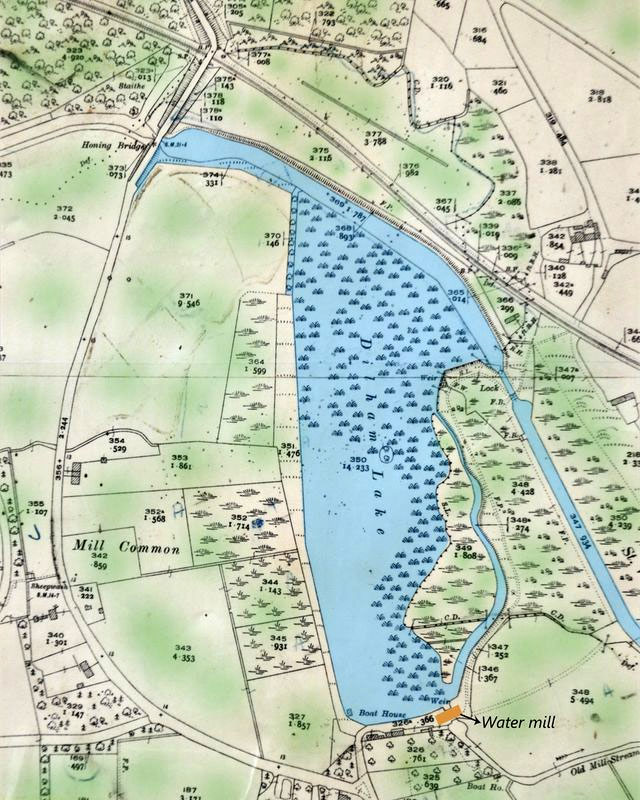 A Broads Authority spokesperson said although no planning applications had been received relating to Dilham Lake, the authority "welcomes applications and will work with the applicant to provide them with information and guidance relating to the planning process." Chris Hill, Eastern Daily Press - 14th August 2021 |
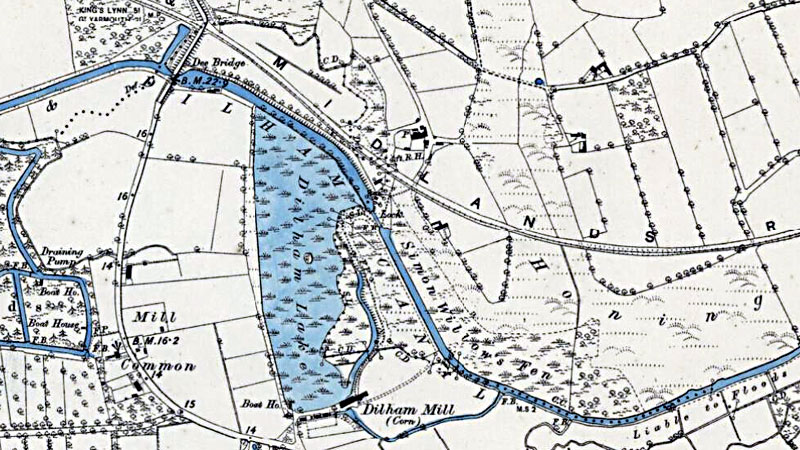 |
O. S. 6" Map 1885 |
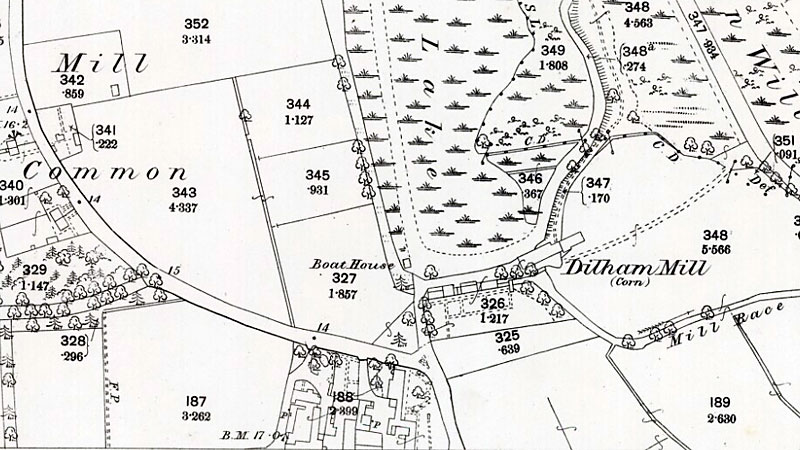 |
O. S. 25" Map 1885 |
1542: Mill and manor house conveyed by Sir Edmund Windham to Robert Townshend
White's 1883: George Holland Shreeve, miller, corn merchant & farmer
Kelly's 1892: William Stackwood, miller (water & steam) |
If you have any memories, anecdotes or photos please let us know and we may be able to use them to update the site. By all means telephone 07836 675369 or
|
| Nat Grid Ref TG3309 2672 | Copyright© Jonathan Neville 2003 |